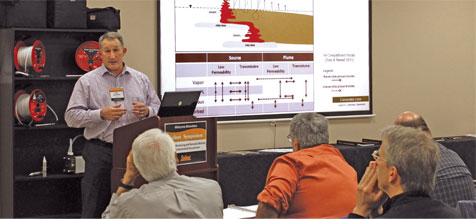
Gary Wealthall gave a very informative talk on dense non-aqueous phase liquid (DNAPL) source zones. He provided an overview of the characteristics of a DNAPL zone, and tools and techniques that can be used to characterize a source zone.
Because of their low solubility, high density and viscosity, DNAPLs tend to persist due to mass transfer limitations to groundwater. Gary showed a study example where 90% of the VOCs were found in the DNAPL source zone, and only 10% in the actual plume. This helped illustrate his point that estimating the mass of the DNAPL source zone is important in determining whether remedial objectives are being met.
Gary discussed his findings from the Source Area BioREmediation (SABRE) project. The SABRE project was a collaborative study undertaken by an international, multidisciplinary team. The project included a highly detailed characterization of a trichloroethene (TCE) source zone, and aimed to quantify DNAPL mass before and after enhanced in situ bioremediation. This involved detailed monitoring, sampling, numerical modeling and statistical analysis.
“All mass estimates are wrong…it’s just a matter of by how much!” Gary stressed that there is no single technique to characterize a DNAPL zone. Characterizations are typically not completely clear, and the resolution decreases with increasing depth and heterogeneity. Therefore, quantifying the uncertainty of the mass estimates should also be considered.
The SABRE site helped in the development of an uncertainty-based performance metric for quantifying the treatment of a trichloroethene DNAPL source zone. The three stage approach taken at the SABRE site involved the use of 3D models to map where the DNAPL might exist, calculate the volume of the subsurface impacted by DNAPL, then quantify mass of DNAPL before and after treatment. A combination of standard sampling and monitoring techniques and 3D visualization helped estimate the uncertainty and DNAPL mass distribution.

ABOUT THE SPEAKER – Gary Wealthall, Ph.D.
GeoSyntec
Gary has more than 20 years’ experience in contaminant hydrogeology research and practice. His academic background includes a Ph.D. in Environmental Engineering from the University of Sheffield and a M.S. in Hydrogeology and Groundwater Chemistry from the University of Reading. He has co-supervised post-graduate projects at a range of universities and was an external examiner (PhD) at the Universities of Cambridge, Edinburgh and Western Australia (Perth).
He joined Geosyntec from the British Geological Survey where he led a research team that focused on the application of process-based research to advance understanding of DNAPL behavior in heterogeneous geological systems for site evaluation, risk assessment, site restoration and performance verification. His technical expertise includes the development and application of high-resolution site characterization methodologies for DNAPLs in fractured bedrock aquifers/aquitards and shallow intergranular aquifers. He was the lead Principal Investigator of the $6M SABRE project, which was a major research initiative to quantify the effectiveness of the remediation of a DNAPL source zone by enhanced in situ bioremediation. Gary is currently undertaking remedial investigation projects for a number of clients at DNAPL sites in North America and Europe, including the development of a new evaluation tool for remedial alternatives selection at complex DNAPL megasites.
Gary is internationally recognized for his expertise in DNAPLs and fractured bedrock and has delivered numerous invited and sponsored lectures and presentations to audiences in the UK, Europe and North America. He is also the author of numerous publications on the fate of NAPLs in aquifer and aquitard systems and has served as expert reviewer to the UK Government and National Agencies including Nirex (NAPL enhanced radionuclide transport), the Ministry of Defence (Depleted Uranium) and the Environment Agency (EA Landfill hydrogeology). His knowledge transfer publications include co-author of the popular EA R&D Publication 133: ‘An Illustrated handbook of DNAPL transport and fate in the subsurface’, and co-author of numerous NAPL and fractured bedrock focused technical bulletins for CL:AIRE (an independent, not-for-profit, UK organization promoting sustainable remediation). He is currently co-authoring a guidance document on the environmental transport and fate of LNAPLs.
